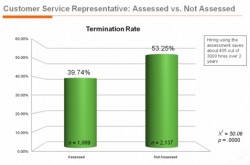 This is a story about how CashAmerica saved millions. And how your company might be able to save money, too.
This is a story about how CashAmerica saved millions. And how your company might be able to save money, too.
Like so many companies, CashAmerica, a nationwide chain of loan and pawnshops, had a retention problem. By the middle part of the last decade the problem had become acute enough that the company regularly operated at 80-90 percent staffing.
That might have been good for the bottom line, but the cycle of hiring and training, not to mention lost productivity, had a cost.
Clint Jaynes, when he took over as SVP of human resources in 2006, figured the cost to be about $2,000 in training costs for every new hire.
As Jaynes studied the matter, he found many newly minted clerks left within the first 90 days; more within six months. By the end of two years, somewhat more than half of all new hires were gone.
Store managers, who cost five times as much to train, had a lower, but still significant turnover rate.
Jaynes suspected that a big part of the problem was in the selection process. Because of the hoary nature of pawnbrokering, hiring was largely done locally. Walk-ins were the norm.
“What drew me was the opportunity to bring some sophisticated tools to the managers,” Jaynes says. “They didn’t have many. They all hired people, but that wasn’t (much of) their training.”
Experienced in using assessments to help select candidates, Jaynes turned to PeopleAnswers. The company uses standardized personality and behavioral assessments, normalizing them against the results obtained by testing existing employees and analyzing their results against their performance.
The results of the high performers are then used by PeopleAnswers to give a thumbs up or down to each candidate.
Other assessment companies use different methods, with the most sophisticated — and pricey — method being the development of custom tests designed for specific jobs at specific companies.
Jaynes chose PeopleAnswers because he was both familiar with the company and knew that its results presentation would be easy for managers to use with minimal training.
At the end of two years, a period when 200 of the company’s 800 stores used the assessments, Jaynes found that where the assessments were in place, clerk turnover was 39.7 percent. In the 600 stores where no assessments were used, turnover was 53.3 percent.
If the entire company had been using assessments, the training savings alone would have been in the neighborhood of $850,000 for the clerk position alone. Manager turnover also declined where the assessments were used in selecting candidates. Add in those costs and the total savings for training alone would have exceeded $1 million.
If the story ended there, it would be a happy ending for CashAmerica. It doesn’t. Besides the training savings, CashAmerica found that revenue increased where the assessments were being used; in some places by $50,000.
“We were able to get a higher-quality person,” says Jaynes. Ironically, that pushed up overall turnover because store managers no longer had to accept mediocre performance and terminated subpar workers. It also cut down on internal theft.
CashAmerica’s success is not an isolated case. Dr. Charles Handler, an industrial psychologist and president and founder of Rocket-Hire, a consultancy in pre-employment testing, screening, and assessment tools, says companies that use assessments see all sorts of benefits.
“Retention for a lot of companies might be a starting point,” he says, “But there are other reasons to use assessments.” Among them: cultural fit, leadership potential, decision-making, career planning, and advancement.
Handler cautions that though there are many assessment companies and tests available, price should never be the deciding factor. Instead, “The more you tailor the assessment to the individual, to the company, to the job, the more accurate and the more value it will show,” he says.
Today, CashAmerica regularly uses assessments everywhere. Turnover is down and performance is up. Not all of it can be attributed to the use of assessments, but that’s where it started.
The complete story and a look at the results other companies are getting with assessments will be in the June issue of the Journal of Corporate Recruiting Leadership.